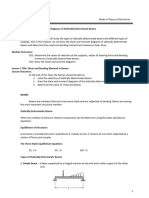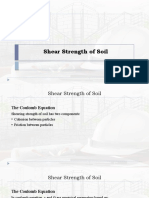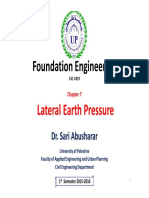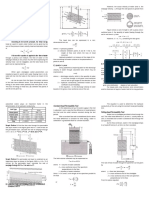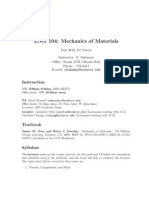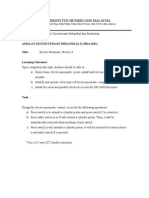0 ratings0% found this document useful (0 votes)
49 viewsin Situ Stresses
in Situ Stresses
Uploaded by
Joanna GuidoThe total stress, pore water pressure, and effective stress were calculated at three points (A, B, C) in a saturated soil column with no seepage. At point A, the total stress and pore pressure are equal, resulting in zero effective stress. At point B, the effective stress depends on the soil and water unit weights and the water height. At point C, the effective stress formula is more complex due to the sloping water table. The groundwater table would need to rise to equalize the effective stress at C to 200 kPa.
Copyright:
© All Rights Reserved
Available Formats
Download as PDF, TXT or read online from Scribd
in Situ Stresses
in Situ Stresses
Uploaded by
Joanna Guido0 ratings0% found this document useful (0 votes)
49 views4 pagesThe total stress, pore water pressure, and effective stress were calculated at three points (A, B, C) in a saturated soil column with no seepage. At point A, the total stress and pore pressure are equal, resulting in zero effective stress. At point B, the effective stress depends on the soil and water unit weights and the water height. At point C, the effective stress formula is more complex due to the sloping water table. The groundwater table would need to rise to equalize the effective stress at C to 200 kPa.
Original Title
9.-IN-SITU-STRESSES
Copyright
© © All Rights Reserved
Available Formats
PDF, TXT or read online from Scribd
Share this document
Did you find this document useful?
Is this content inappropriate?
The total stress, pore water pressure, and effective stress were calculated at three points (A, B, C) in a saturated soil column with no seepage. At point A, the total stress and pore pressure are equal, resulting in zero effective stress. At point B, the effective stress depends on the soil and water unit weights and the water height. At point C, the effective stress formula is more complex due to the sloping water table. The groundwater table would need to rise to equalize the effective stress at C to 200 kPa.
Copyright:
© All Rights Reserved
Available Formats
Download as PDF, TXT or read online from Scribd
Download as pdf or txt
0 ratings0% found this document useful (0 votes)
49 views4 pagesin Situ Stresses
in Situ Stresses
Uploaded by
Joanna GuidoThe total stress, pore water pressure, and effective stress were calculated at three points (A, B, C) in a saturated soil column with no seepage. At point A, the total stress and pore pressure are equal, resulting in zero effective stress. At point B, the effective stress depends on the soil and water unit weights and the water height. At point C, the effective stress formula is more complex due to the sloping water table. The groundwater table would need to rise to equalize the effective stress at C to 200 kPa.
Copyright:
© All Rights Reserved
Available Formats
Download as PDF, TXT or read online from Scribd
Download as pdf or txt
You are on page 1of 4
SOLMEC 414 – SOIL MECHANICS B.
CONCEPT OF EFFECTIVE STRESS h = height of the column of moist soil
1st SEM. A.Y. 2022 – 2023 Stress in soils can be thought as an overburden The equation suggests that the effective stress
pressure or load above a point of consideration caused by caused by moist soils is equal to the total stress. The pore
CHAPTER 9: IN SITU STRESSES all the things that are above that point. The effective stress, water pressure is neglected even though that the soil has
however, is the stress induced by the soil particles only. water in it.
A. INTRODUCTION Initially, consider a dry soil. The total stress caused
Soil is a multi-phase system with soil particles by this mass is simply caused by the weight of the soil
randomly distributed in a given soil mass with continuous particles then the total stress is equal to the effective stress
void spaces in between which may be totally filled by water or
(saturated soil) or totally filled with air (dry soil) or may be σ = σ’
filled with water and air (moist soil). As an engineering When water is added to soil until it becomes
material, the nature with which the stress distribution along saturated, the total stress at point in the soil is due to the
a given cross section of the soil profile must be known. saturated weight of the soil and the standing water or in
The determination of such is very essential to other terms, total stress is also due to the stress caused by
geotechnical engineering because soil stresses relates to the soil particles which is the effective stress and the stress
problems involving compressibility of soils, shear strength, caused by the column of water which is known as the pore
bearing capacity of foundations, stability of embankments water pressure, or C. STRESSES IN SOIL WITHOUT SEEPAGE
and lateral earth pressure on earth-retaining walls. When a σ = σ’+ u
load is applied to soil, it is carried by the solid grains and Rearranging the equation and computing the effective
the water in the pores. stress gives
The total vertical stress (when thought as a load) σ’ = σ – u
acting at a point below the ground surface is due to the It suggests that, effective stress is simply equal to total
weight of everything that lies above, including soil, water, stress minus pore water pressure at the point of
and surface loading. Total stress thus increases with depth consideration.
and with unit weight. The total stress (when thought as a Physically, when water filled the continuous void
reactive force), σ, can be divided into two parts: spaces in the soil, the particles are then submerged. Thus,
1. A portion of the total vertical stress or load is carried each of the particles is then subject the buoyant force that
by water in the continuous void spaces, which in turn, offers an uplift action, thus reducing the net downward
called the pore water pressure, u. This portion acts force offered by the soil particles. When the soil is dry, then
with equal intensity in all directions and is also the pore water pressure is zero.
referred to as the neutral stress. In any case, soil can be moist - that is 0 < S <
2. The rest total vertical stress or load is carried by the 100%. For this condition water in the void spaces is not
soil solids or soil skeleton at their point of contact. The continuous, and it is a three phase system thus creating a
sum of the vertical components of the forces discontinuity in the computation of the pore water pressure.
developed at the points of contact of the solid particles The total stress at any point consists of intergranular, pore
per unit cross-sectional area of the soil mass is called air and pore water pressures. Since this pressures are
the effective stress, σ’. simply intergranular, an estimate of the effective stress for With reference to figure where it shows a column of
moist soil can be given by saturated soil with no seepage of water in any direction.
σ’ = σ = γh The total stress at point A is the weight of the saturated soil
where γ = moist unit weight of the soil. and the water above the soil or
σ = γsat (HA – H) + γw H be expected that the seepage force, which is directly At point A
where γsat = saturated unit weight of the soil proportional to the energy head of the flowing water, is Total stress: σ A = H1 w
γw = unit weight of water decreasing due the increasing head losses as the water Pore water pressure: u A = H1 w
H = height of the water above the saturated soil. particles moves up. Effective stress: σ' A = σ − u = 0
HA = total height of the water up to point A. Figure shows a layer of soil in a tank where a At point B
In determining the effective stress from the equation constant rate of flowing water is introduced at the bottom of Total stress: σ B = H1 w + H 2 sat
σ’ = σ – u the tank which in turn causes an upward seepage through Pore water pressure: u B = ( H1 + H 2 + h) w
gives the particles. It can also be thought that the water in point B Effective stress: σ' B = σ B − u B
σ’ = (Height of the soil column) × γ’ has a greater energy or water pressure compared to the = ( H1 w + H 2 sat ) − ( H1 + H 2 + h) w
water at any point above point B. So when piezometers are
where γ’ = γsat - γw = H 2 ( sat − w ) − h w
inserted at different elevations along the soil as in point C
= effective unit weight or submerged unit weight
and point A, the piezometric level at B is higher compared At point C σ' B = H 2' − h w
Sample Problem 1: A soil profile is shown in the figure.
to the levels at point C and A. It also follows that the Total stress: σ C = H1 w + z sat
(a) Calculate the total stress, pore water pressure, and
piezometric level at C is greater than at A.
effective stress at points A, B, and C. (b) How high should h
Pore water pressure: uC = H1 + z + z w
the ground water table rise so that the effective stress at C H 2
is 200 kPa?
Effective stress:
σ' C = σ C − uC
h
= H1 w + z sat − H1 w − z w − z w
H2
h
= z ( sat − w ) − z w
H2
h
σ' C = z ' − z w
H2
The loss of head between points A and B is h. From the effective stress at point C, the expression
Recall that the head loss proportional to the distance h/H2 is the hydraulic gradient i caused by the flow and
travelled by the water particle from point to point. Thus, at therefore
any point distance below point A, the head loss is equal to σ' C = z ' − i z w
h From the equation, due to upward seepage, the effective
z stress at the point located at a distance z measured from
H2 the surface of the soil layer is reduced by an amount izγw.
Similarly, the quantity represents the difference in If the rate of seepage is gradually increased, the
piezometric levels from the point to point A. hydraulic gradient thereby gradually increase until a limiting
D. STRESSES IN SATURATED SOIL WITH SEEPAGE
Keeping in mind that effective stress is equal to the condition will be reached at which the effective stress
• UPWARD SEEPAGE
total stress minus pore water pressure. But in this case becomes zero, or
When a soil mass is subjected to water seeping
when seepage is present, the pore water pressure is the
upward, the force induced by the flowing fluid is also σ' C = z ' − icr z w = 0
equal to the pressure induced by the height of the column
directed upward. In other words this force is an additional
of water in the piezometer at the point being considered. where icr = critical hydraulic gradient.
to the present buoyant force pushing the particles up. Thus,
The stress calculations at different points are as follows:
this action decreases the effective stress. However, it is to
h
Under such condition, the soil stability is lost. This situation C = z ' + z w Sample Problem 2: Consider the upward flow of water
is generally referred to as boiling or quick condition. H2 through a layer of sand in the tank shown in the figure. For
σ' C = z ' + i z w the sand, the following properties are given: e = 0.52 and
• DOWNWARD SEEPAGE Gs = 2.67. (a) Calculate the total stress, pore water
The effect of downward seepage is the reverse of D. SEEPAGE FORCE pressure and the effective stress at points A and B. (c)
the effect of upward seepage. Thus the force caused by the As discussed previously, it can be shown that, with Calculate the upward seepage force per unit volume of soil.
downward seepage increases the effective stress. The no seepage, the effective stress at any distance below the
process of determining the effective stress at any point on soil layer is equal to zγ’, Thus the effective force acting on
the soil is the same as with upward seepage – effective an area is
stress equals total stress minus pore water pressure (σ’ = σ
F1 = z 'A
– u) at the point being considered or analyzed. But, taking If there is an upward seepage of water in the vertical
note that the pore water pressure is the pressure is the direction the effective stress is decreased by an amount of
equal to the pressure induced by the height of the column izγw as previously discussed. This makes the effective force
of water in the piezometer at the point being considered. with upward seepage over an area to be
The hydraulic gradient caused by the downward seepage
F2 = z (' − i w ) A
equals i = h/H2.
Hence the decrease in the total force because of seepage
is
F1 − F2 = z'A − z (' − i w ) A = iz w A
But the weight of the soil contributing to the effective stress
has the volume zA, so the seepage force per unit volume
of the soil is
F1 − F2 iz w A Sample Problem 3: A 20-ft thick layer of saturated clay is
= = i w
(Volume of soil) zA underlain by a layer of sand. The sand is under artesian
For downward seepage, seepage force is also equal to iγw. pressure. Calculate the maximum depth of cut H that can
be made in the clay
The stresses at point C are as follows:
Total stress: σ C = H1 w + z sat
h
Pore water pressure: uC = H1 + z − z w
H 2
Effective stress:
σ' C = σ C − uC
h
= H1 w + z sat − H1 w − z w + z w
H2
h
= z ( sat − w ) + z w
H2
Sample Problem 4: Consider the downward flow of water It can be thought that, due to the attraction
through a layer of sand in the tank shown in the figure. For between the liquid particles in the surface and the tube, where S = degree f saturation at the zone of capillarity, in
the sand, the following properties are given: e = 0.48 and fluid molecules are being pulled up or sucked up which percent.
Gs = 2.7. (a) Calculate the effective stress at point A and causes the liquid to rise up. With this analogy, the suction
(b) Calculate the effective stress at point B. effect causes the water pressure at a point in the capillary Sample Problem 5: A soil profile is shown in the figure. Given
rise to be a negative pressure! that H1 = 2 m, H2 = 1.8 m, H3 = 3.2 m. Plot the variation of
It can be seen that capillary rise is inversely σ, u, and σ’ with depth.
proportional to the diameter of the tube, that is
1
h
d
which means that when the diameter of the tube is getting
smaller the capillary rise increases.
Since soil has continuous voids with water as the
fluid (commonly) that comes from the natural ground water
table, this voids may act as bundles of capillary tube or
varying cross-section. Due to this reason, Hazen (1930)
gave a formula to give the approximate height of capillary
E. CAPILLARY RISE IN SOIL rise in the form
In fluid mechanics, when a tube with diameter d is C
h (mm) =
inserted to a liquid the liquid surface will rise through the eD10
tube due to the adhesion between the tube and the liquid. where C = a constant that varies from 10 to 50 mm2
The capillary rise h, which is the height of the rise of the D10 = effective size (mm)
fluid in the capillary tube, is given by e = void ratio
4σ cos θ
h=
d F. EFFECTIVE STRESS IN THE ZONE OF CAPILLARY
where σ = surface tension of the fluid (force/length) RISE
θ = angle of contact between the fluid and the tube In general, relationship between the total stress,
γ = unit weight of the fluid effective stress and pore water pressure is given by
σ = σ' + u or σ' = σ − u
It has been noted that the pore water pressure at a point in
a layer of fully saturated zone of capillary rise is a negative
pressure which is equal to
u = − w h
where h = height of the point under consideration
measured from the ground water table.
The atmospheric pressure which is at the water
table is taken as the datum. If partial saturation is caused
by the capillary action, the pore water pressure can be
approximated as
S
u = − wh
100
You might also like
- ANSI - HI 9.8 2012 Rotodynamic-Pumps-For-Pump-Intake-DesignDocument132 pagesANSI - HI 9.8 2012 Rotodynamic-Pumps-For-Pump-Intake-DesignWissam Jarmak100% (4)
- Week 1112 Vertical StressesDocument131 pagesWeek 1112 Vertical StressesJerald ManrealNo ratings yet
- Review of Soil Mechanics PDFDocument98 pagesReview of Soil Mechanics PDFLorence OmbaoNo ratings yet
- Access Full Solution ManualDocument10 pagesAccess Full Solution ManualHunegnaw AynalemNo ratings yet
- 1 Basic Soil PropertiesDocument46 pages1 Basic Soil PropertiesJeffLeung100% (1)
- Elementary Surveying Lecture Part 2Document4 pagesElementary Surveying Lecture Part 2Edenjade MacawiliNo ratings yet
- In-Situ Stresses in SoilDocument26 pagesIn-Situ Stresses in SoilhashimshahNo ratings yet
- P5 Effective StressDocument28 pagesP5 Effective StressMiguel TabaNo ratings yet
- 315C - Stress in Soil Due To Self WeightDocument34 pages315C - Stress in Soil Due To Self WeightTyn MaturanNo ratings yet
- Some Theorems On Right TrianglesDocument4 pagesSome Theorems On Right TrianglesGlecy AdrianoNo ratings yet
- Module 2 Shear and Moment in Determinate BeamsDocument13 pagesModule 2 Shear and Moment in Determinate BeamsshnslaveNo ratings yet
- Effective Stress in Soil SeeeeDocument6 pagesEffective Stress in Soil SeeeeRajesh KhadkaNo ratings yet
- Practice Problems 14: Influence LineDocument8 pagesPractice Problems 14: Influence LineMikhael Wakin RodriguezNo ratings yet
- Principle of Steel Design Reviewer 01Document21 pagesPrinciple of Steel Design Reviewer 01Monicajean CequenaNo ratings yet
- تربة جامعة المصطفىDocument15 pagesتربة جامعة المصطفىيوسف السعديNo ratings yet
- Taller PavDocument2 pagesTaller PavDänhiellGäonäRinconNo ratings yet
- CE225 SM 15 Stresses in SoilDocument46 pagesCE225 SM 15 Stresses in SoilM Modood Abbasi AbbasiNo ratings yet
- Transformation of Coordinates PDFDocument2 pagesTransformation of Coordinates PDFMa Ella Mae LogronioNo ratings yet
- 5 CE131P - Beams and Frames - Shear and Bending Moment (Robles)Document23 pages5 CE131P - Beams and Frames - Shear and Bending Moment (Robles)Marion Frea PlazoNo ratings yet
- COMPACTION OF SOILS (Loiza)Document2 pagesCOMPACTION OF SOILS (Loiza)Loiza Joi MulanoNo ratings yet
- Refresher Course Module - Structural Engineering: Hakuna Matata"Document1 pageRefresher Course Module - Structural Engineering: Hakuna Matata"Mohammad Hussein Masiu BacaramanNo ratings yet
- 3.2.7 Rankine's Earth Pressure in Cohesive SoilsDocument21 pages3.2.7 Rankine's Earth Pressure in Cohesive SoilsMriduNo ratings yet
- Strema ProblemsDocument3 pagesStrema ProblemsGerrard PantopioNo ratings yet
- Determinacy and IndeterminacyDocument12 pagesDeterminacy and IndeterminacyMode NaseerNo ratings yet
- Foundation Engineering. 02 Soil Compressibilty. Edited. 15 Feb 2020Document8 pagesFoundation Engineering. 02 Soil Compressibilty. Edited. 15 Feb 2020sammy lopezNo ratings yet
- Foundation Engineering: Module 2: Geotechnical Properties of SoilDocument4 pagesFoundation Engineering: Module 2: Geotechnical Properties of SoilAljon AvilaNo ratings yet
- Chapter4 Shear StrengthDocument17 pagesChapter4 Shear StrengthMuhd FareezNo ratings yet
- 5.shear Strength of SoilDocument25 pages5.shear Strength of SoilGladys LeonorNo ratings yet
- RC Notes 9-16Document4 pagesRC Notes 9-16AngelohNo ratings yet
- Permeability Test B M DAS PDFDocument18 pagesPermeability Test B M DAS PDFSumit ThakurNo ratings yet
- Soil Mechanics Chapter 4Document20 pagesSoil Mechanics Chapter 4Kc Kirsten Kimberly MalbunNo ratings yet
- Refresher 120Document2 pagesRefresher 120Jessie CaidoNo ratings yet
- CE 470-Lect-3 (Analysis of Biaxially Loaded Columns) (Read-Only)Document22 pagesCE 470-Lect-3 (Analysis of Biaxially Loaded Columns) (Read-Only)Jamal RkhNo ratings yet
- Earthquake Engineering LectureDocument12 pagesEarthquake Engineering LectureMeverlyn RoqueroNo ratings yet
- 4model Exam Soil Mechanics IIDocument5 pages4model Exam Soil Mechanics IITsegaye KebedeNo ratings yet
- 06 Chapter 7 - Lateral Earth Pressure-MDocument62 pages06 Chapter 7 - Lateral Earth Pressure-Mthuaiyaalhinai100% (1)
- Problem Set (Math and Surveying) PDFDocument8 pagesProblem Set (Math and Surveying) PDFIrene Grace BatalaoNo ratings yet
- Lesson 5 Earthquake DescriptorsDocument12 pagesLesson 5 Earthquake Descriptorspoliman2017No ratings yet
- Pre-Stressed Elective EngineeringDocument7 pagesPre-Stressed Elective EngineeringJonas FernandezNo ratings yet
- Chapter 4 Soil Retaining StructuresDocument101 pagesChapter 4 Soil Retaining StructuresAlemayehu MitekuNo ratings yet
- GEAS - Problems 1Document7 pagesGEAS - Problems 1Martys HubNo ratings yet
- Soil-Bearing Capacity For Shallow FoundationsDocument9 pagesSoil-Bearing Capacity For Shallow FoundationsNguyễn Thanh TrựcNo ratings yet
- 1geotechnical Engineering - Review PDFDocument5 pages1geotechnical Engineering - Review PDFreynoldNo ratings yet
- Phase Relation of Soils: Index Properties of Soil: Mass-Volume RelationshipDocument4 pagesPhase Relation of Soils: Index Properties of Soil: Mass-Volume RelationshipMarben Leynes-Cereno Agustin-ViernesNo ratings yet
- Refresher Module 03 Geotechnical Engineering and HydraulicsDocument2 pagesRefresher Module 03 Geotechnical Engineering and HydraulicsJennylyn TayabNo ratings yet
- Note 4Document5 pagesNote 4Mohamaad100% (1)
- CH 11 Compressibility of Soil4Document14 pagesCH 11 Compressibility of Soil4Boni ClydeNo ratings yet
- 03 Chapter 4 - Plasticity and Structure of SoilDocument47 pages03 Chapter 4 - Plasticity and Structure of SoiltarekismailsabryNo ratings yet
- Week 11 12 Soil Compaction 1Document8 pagesWeek 11 12 Soil Compaction 1Johnri RamirezNo ratings yet
- F 100 R M M M X 100: Particle Size DiameterDocument5 pagesF 100 R M M M X 100: Particle Size DiameterNely ZulfatnNo ratings yet
- Ce Review Nov 2021 PI Description: Min MaxDocument9 pagesCe Review Nov 2021 PI Description: Min MaxJoseph LantoNo ratings yet
- CEP233 - M1 - Definition Classification and Types of SurveysDocument15 pagesCEP233 - M1 - Definition Classification and Types of SurveysAdrian SamonteNo ratings yet
- Thin Walled Pressure VesselsDocument4 pagesThin Walled Pressure VesselsBillyIlustrisimoNo ratings yet
- Hydrogeo Preboard 3 ADocument6 pagesHydrogeo Preboard 3 ALester SarmientoNo ratings yet
- HydraulicsDocument11 pagesHydraulicsMarvin BermidoNo ratings yet
- Stresses in SoilDocument37 pagesStresses in SoilRadhaAnanthalekshmiNo ratings yet
- Hydraulic 2Document52 pagesHydraulic 2Othmane BoualamNo ratings yet
- Review Module 21-Geotechnical Engineering 2 - Part 2Document2 pagesReview Module 21-Geotechnical Engineering 2 - Part 2Cyrus Flores,No ratings yet
- Effective Stress ConceptDocument3 pagesEffective Stress ConceptRhey LuceroNo ratings yet
- Effective Stress in The GroundDocument13 pagesEffective Stress in The GroundSabby SaberonNo ratings yet
- Disruptive Technologies and Connected and Automated Vehicles 1Document61 pagesDisruptive Technologies and Connected and Automated Vehicles 1Joanna GuidoNo ratings yet
- Chapter 4 - AsphaltDocument31 pagesChapter 4 - AsphaltJoanna GuidoNo ratings yet
- Stresses in A Soil MassDocument6 pagesStresses in A Soil MassJoanna GuidoNo ratings yet
- Aerodrome Standards. 4Document29 pagesAerodrome Standards. 4Joanna GuidoNo ratings yet
- Compressibility of SoilDocument7 pagesCompressibility of SoilJoanna GuidoNo ratings yet
- Transportation EconomicsDocument130 pagesTransportation EconomicsJoanna Guido100% (1)
- Permeability of SoilsDocument6 pagesPermeability of SoilsJoanna GuidoNo ratings yet
- 2019 December BE10106-H - Ktu QbankDocument2 pages2019 December BE10106-H - Ktu QbankruhulNo ratings yet
- JCP 10 12 SeriesDocument1 pageJCP 10 12 SeriesAlban HysomemajNo ratings yet
- 400 HydraulicsDocument35 pages400 HydraulicsMrAlbert2009No ratings yet
- Paul Allemeersch - Polymerisation of Ethylene - in Slurry Loop Reactors-De Gruyter (2015)Document206 pagesPaul Allemeersch - Polymerisation of Ethylene - in Slurry Loop Reactors-De Gruyter (2015)Roger David Melendez GuevaraNo ratings yet
- Experiment No: Date: Determination of Bulk Density, Tap Density and Compressibility IndexDocument8 pagesExperiment No: Date: Determination of Bulk Density, Tap Density and Compressibility IndexVishwajeet Ghorpade100% (2)
- SyllabusDocument2 pagesSyllabusValeriy PulberNo ratings yet
- ch8 Steady Incompressible Flow in Pressure Conduits (Partb) PDFDocument66 pagesch8 Steady Incompressible Flow in Pressure Conduits (Partb) PDFnaefmubarak0% (1)
- Vortex Formula BookDocument5 pagesVortex Formula BookCristian GiurgeaNo ratings yet
- A-Hydraulics 2 7-12-05 (Rev 2-06) .PpsDocument138 pagesA-Hydraulics 2 7-12-05 (Rev 2-06) .Ppscarolina Portocarrero100% (1)
- Base Units, Properties of Fluids, and Unit Pressures: CE Review For Nov 2022 - Hydraulics 1Document1 pageBase Units, Properties of Fluids, and Unit Pressures: CE Review For Nov 2022 - Hydraulics 1Jocelyn CabarlesNo ratings yet
- Lab PracticeDocument14 pagesLab Practicesaliana binti sanusi50% (2)
- SVAAR - Product Brochure 1Document6 pagesSVAAR - Product Brochure 1jpsingh75No ratings yet
- Prinsip Le ChatelierDocument8 pagesPrinsip Le ChatelierYee YinNo ratings yet
- Class 11415Document10 pagesClass 11415ahmadreza777No ratings yet
- SKF 4513 Plant Design 1: HEURISTICS (Rules of Thumb) FOR Process SynthesisDocument36 pagesSKF 4513 Plant Design 1: HEURISTICS (Rules of Thumb) FOR Process SynthesisThrishnaa BalasupurManiam0% (1)
- Sustainable Drainage SystemDocument49 pagesSustainable Drainage SystemMuhammad Arya WisesaNo ratings yet
- Water Supply-3Document15 pagesWater Supply-3mohammad yaseenNo ratings yet
- Properties of Fluids: - Basic Concepts andDocument10 pagesProperties of Fluids: - Basic Concepts andEISLEY CADDAUANNo ratings yet
- Manual Tecnico Valvula Norriseal Serie 2-2220Document7 pagesManual Tecnico Valvula Norriseal Serie 2-2220Dany GarciaNo ratings yet
- Numerical Study On Flow Past 2D Square Cylinder by Large Eddy Simulation - Comparison Between 2D and 3D ComputationsDocument8 pagesNumerical Study On Flow Past 2D Square Cylinder by Large Eddy Simulation - Comparison Between 2D and 3D ComputationsMai ZhangNo ratings yet
- Actuator Disc Methods Applied To Wind Turbines: Robert MikkelsenDocument121 pagesActuator Disc Methods Applied To Wind Turbines: Robert MikkelsenEsojzerepNo ratings yet
- Unit 3 HydraulicvalvesDocument76 pagesUnit 3 HydraulicvalvesArnav SharmaNo ratings yet
- DesignBuilder Simulation Training - HSD PDFDocument20 pagesDesignBuilder Simulation Training - HSD PDFnpnbkck100% (2)
- PDFDocument3 pagesPDFMonu singhNo ratings yet
- Lecture 3 - Forced ConvectionDocument98 pagesLecture 3 - Forced ConvectionNgọc ĐàoNo ratings yet
- Plotting Pressure Coefficient Distribution For Airfoils: Calculation of CDocument19 pagesPlotting Pressure Coefficient Distribution For Airfoils: Calculation of CMarisha BhattiNo ratings yet
- Fine Filter For Control Gas HON 905: Product InformationDocument8 pagesFine Filter For Control Gas HON 905: Product InformationMasterch ScheungNo ratings yet
- A CFD Study On The Stability of A Hydraulic Pressure Relief ValveDocument8 pagesA CFD Study On The Stability of A Hydraulic Pressure Relief ValveDrogueria MALUNo ratings yet
- Astral Aquarius Plumbing SystemDocument36 pagesAstral Aquarius Plumbing SystemUnna MalaiNo ratings yet










